- 02 Nov 2023
- 10 Minutes to read
-
Print
-
DarkLight
Workflow
- Updated on 02 Nov 2023
- 10 Minutes to read
-
Print
-
DarkLight
CobbleStone® University Certification Program - Unit 3
Workflow is primarily used to automate approval processes and create conditional notifications/alerts.
Adding a "One-Off" Task
Contract Tasks: Adding a "One-Off" Task
1. Select Add Task from the Tasks, E-mails, Workflow, Alerts menu on the Contract Record Details screen.
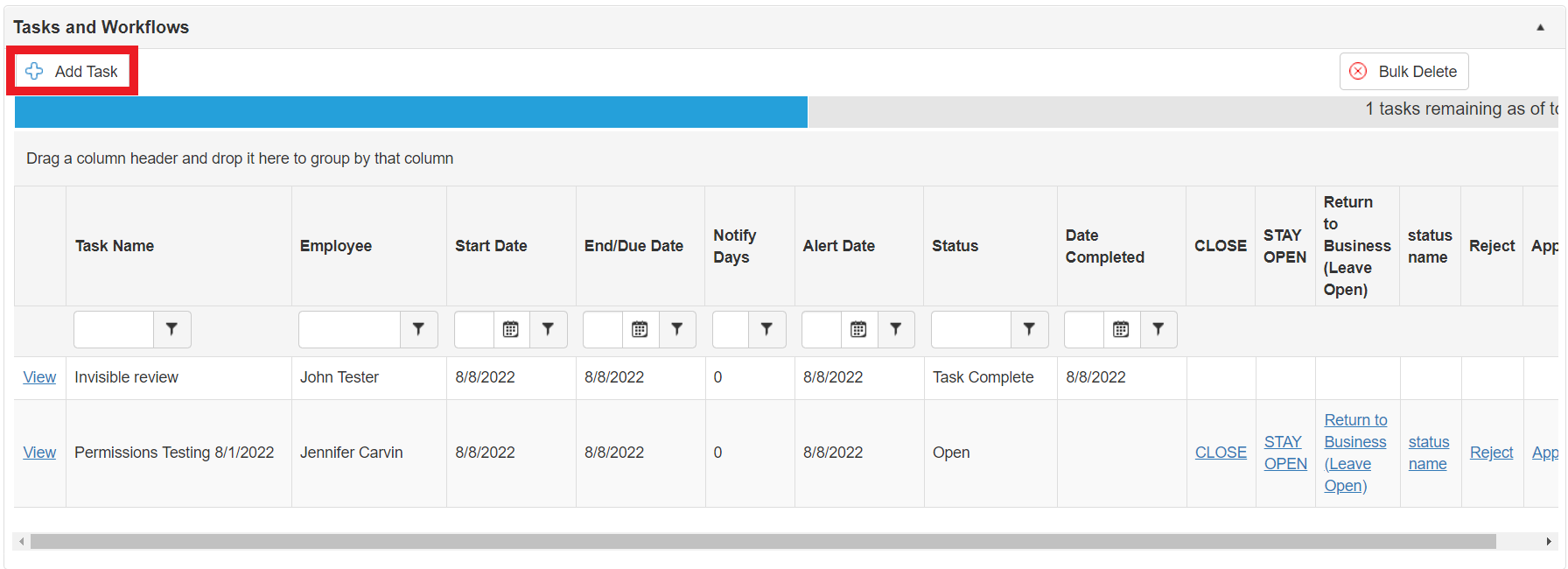
2. Enter the required information into the Add Task screen and select Save & Continue. Task creation can be cancelled by clicking Return to Contract Details on the side menu.

To watch a video on one-off tasks, watch the video below.
Create a New Workflow
Create New Workflow
The Workflow Manager allows you to configure and manage Workflow, which will automatically generate Tasks whenever specific Field Criteria is/are met. To Manage Workflow, navigate to Manage/Setup > Workflow Manager. Note that no Workflow come out-of-the-box at this time; all Workflow must be user-created.
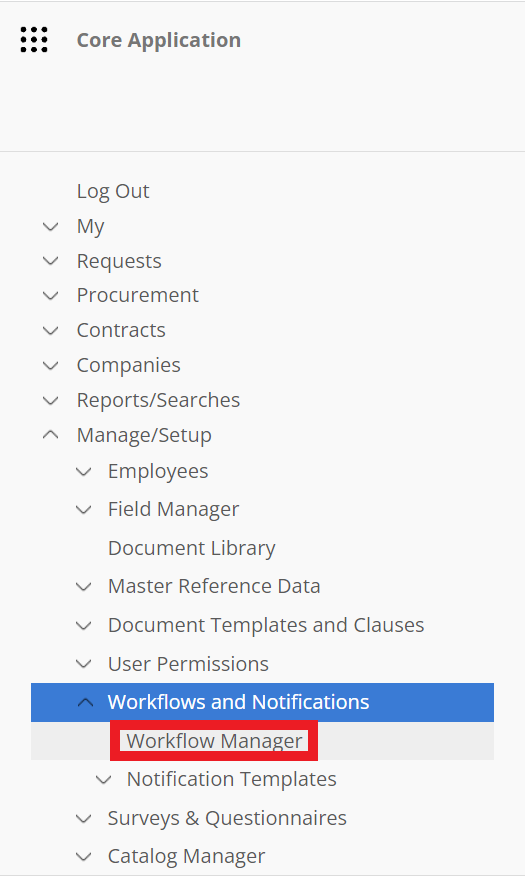
If there are any, a list of existing Workflow displays. To create a new Workflow, click Add New Workflow.

The Add Workflow Job page displays. The page contains numerous important details.
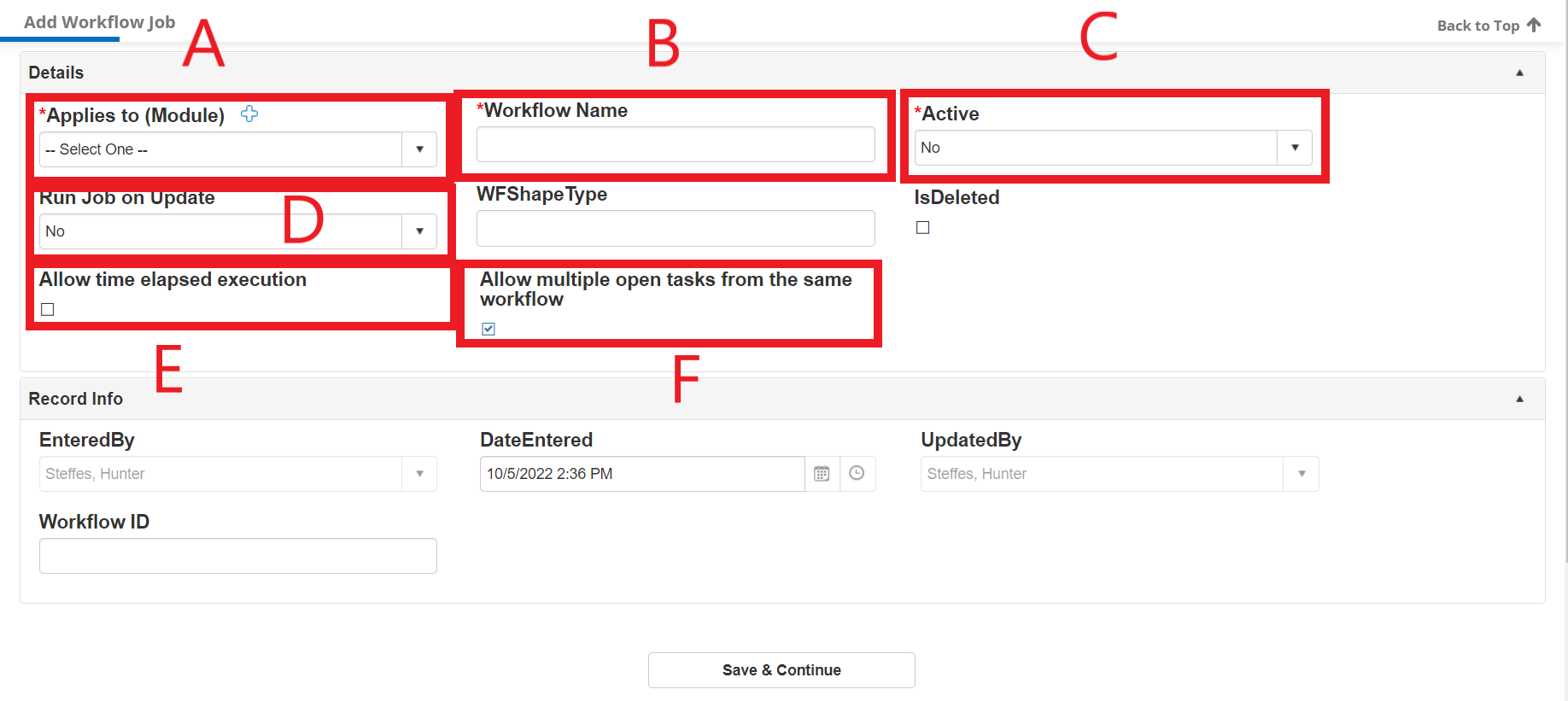
A. Applies to (Module): Which area of the system (table) is the Workflow looking at to trigger? Think about what kind of Task to be generated; a Contract Task, a Request Task, or a Vendor Task? Other Tables available, but generally speaking, an administrator will select one of those three options. Workflow can trigger on Custom Sub-Table Entries, select the appropriate Sub-Table as applicable.
B. Workflow Name: Type in the name of the Workflow being added.
C. Active: Designate whether or not the Workflow is Active. If it is not Active, it will never trigger, even if its Field Criteria is met.
D. Run Job on Update: Designate whether or not the Workflow should trigger if an existing record is updated to meet its Field Criteria. If this is set to No, the Workflow will only ever trigger when adding the associated record.
E. Allow Time Elapsed Execution: Designate if the Workflow should trigger only on a specified date.
Note: If Allow Time Elapsed Execution is set to yes, a condition/criterion must be set to look for a date. The SQL may need to be modified. Ensure assistance from CobbleStone® or an individual in SQL helps with such.
F. Allow Multiple Time Elapsed Tasks from Open Workflow: If the Workflow is set to allow time elapsed execution, designate if multiple of that task - if open - can exist at once on a single record.
It may not seem so at first glance, but Workflow ID, EnteredBy, DateEntered, and UpdatedBy are all System Fields. The system completes these fields automatically.
When finished, click Save & Continue to create the new Workflow.
As a general rule, Run Job on Update, Applies To (module), Active, and Workflow Name are very important when first creating a workflow step.
To watch more on the Workflow overview, watch the video below.
Criteria Creation and Management
Criteria Creation & Management
This page is a continuation of the Create New Workflow page, but the information here can also be used independently/for existing Workflow. Workflow are triggered from field conditions being met or, if using a time elapsed workflow, arriving on a specific date.
1. Click the Conditions tab to navigate to the selection area. Click Add Condition.

For this example, we are looking to construct a Workflow that will trigger for Contract Records that have their Status set to Pending, so we will select our Criteria accordingly. Unlimited conditions may be added.
2. Open the Field menu to select the field against which the criterion is to be set.
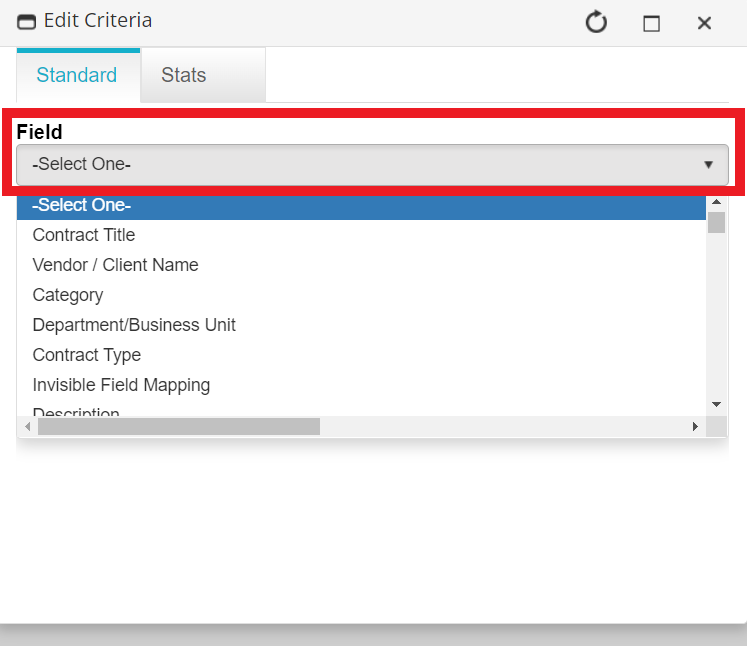
3. The Value menu displays. Select or enter the value for the criterion.
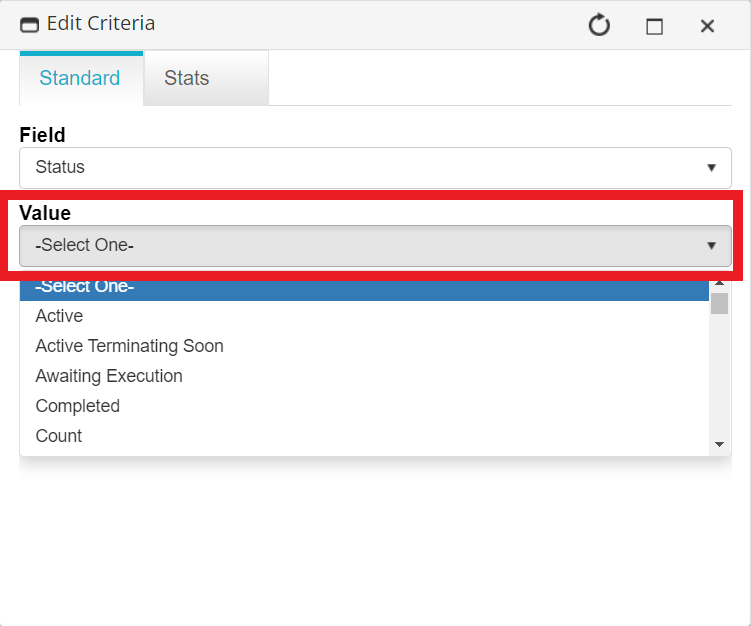
4. Be sure to click Save after selecting/entering the values.
Note: the Value area changes accordingly with the type of field being worked with. Date fields will provide a date range with which to work and Text Box fields will provide a text box for you to type in the criteria value.
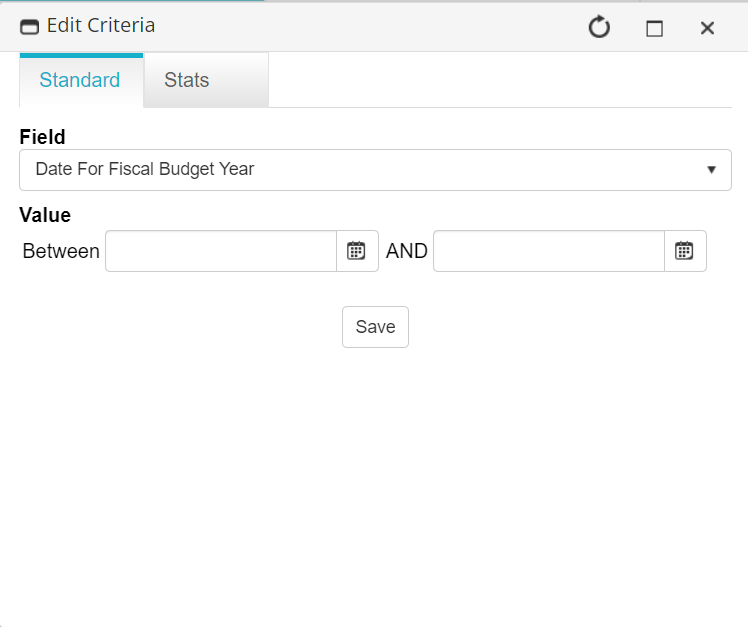
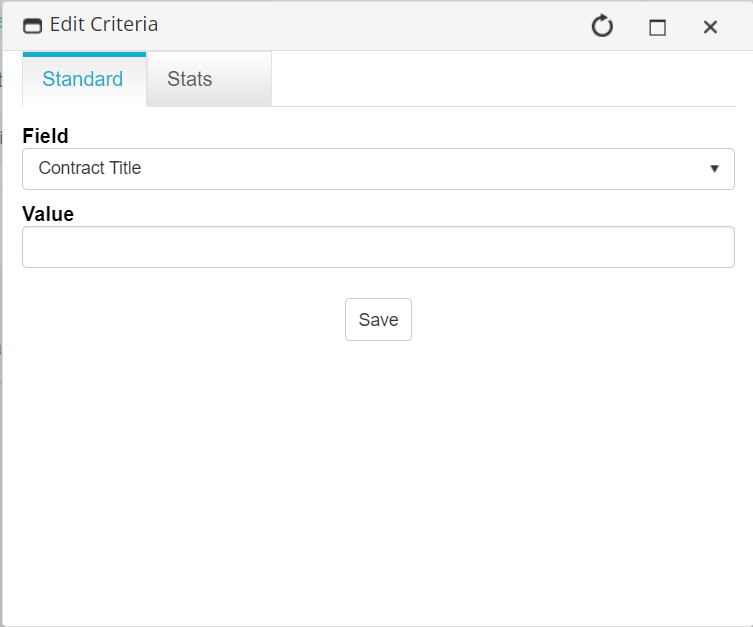
After the Workflow Criterion has been added, it will appear in the list of Workflow Criteria, along with buttons to Delete or Manage/Edit. To edit Workflow Criteria, it is often easier to delete and then re-add than to edit the criteria, as it will involve manually editing the text of each criterion. For more advanced or intricate adjustments to Workflow Criteria, we recommend working directly with your Implementation Specialist or reaching out to CobbleStone® Support.
Please note that any changes to Workflow Criteria will only come into affect when the Workflow is triggered after the changes are confirmed.

Note: If working with date-based workflow and criteria, the condition will need to be edited and an advanced SQL statement put in its place. For example, if triggering a task based on the date being equal to the expiration date, the statement might look something like this: DATEDIFF(d,GetDATE(),Contract_End_Date) = 0.
To watch more on creating conditions, watch the video below.
Task Creation and Management
Workflow Management: Task Creation & Management
This page is a continuation of the Criteria Creation & Management page, but the information here can also be used independently/for existing Workflow.
Click the Task tab to navigate to the Task List. What is essentially an Add Screen for a new Task displays. Using this, detail the Task that will be triggered when the Workflow Criteria are met.

Employee: The Employee the Workflow Task will be assigned to. Due to the variable nature of Workflows, tasks can be assigned to a variety of Employees, including:
- Employee: The Employee Assigned to the record which triggers the Workflow
- Employee’s Manager: The Manager of the Employee Assigned to the record which triggers the Workflow
- Entered By: The Employee who entered the record which triggers the Workflow
- Updated By: The Employee who last updated the record which triggers the Workflow
Auto Rotate: Alternately, a Task can be assigned to a specific Role/Group and then assigned to a Role/Group member by Sort Order, Sort Order - Fill Count, or Sort Order - Even Distribution.
Role/Group: Optionally, assign an Employee Role/Group to the Task as well. Members of the Role/Group will be treated as if they were the Employee Assigned to the Workflow Task, meaning they will receive the Task Alerts and, dependent on their Permissions, be able to Accept/Reject the Task.
Task Title/Name: The Title or Name of the Task that will be generated.
Task Note/Description: Details of/instructions for the Task, including what, if anything, is expected of the recipient.
Task Start Date and End Date: Due to the variable nature of Workflow (it can be triggered any time the Criteria are met), the Start Date and End Date are based on variables as well. A good rule of thumb is to start with the right-most drop down, selecting which Date Field you’ll base the Task Date on, and then designate that date to be X number of days Before or After the value of that Date Field. In our example, we’ll see that the Start Date is set to 0 days before record’s Date Updated, and the End Date is set to 7 days after record’s Date Updated. Therefore, the Task Start Date will be set to the day the record triggers the Workflow, and the Task End Date will be 7 days later.
Non-Working Days: Non-Working Days can be applied to ensure that Task Dates do not fall on Non-Working Days. Tracking Only means this feature is not being used, while setting it to Adjust End Date will turn on the functionality and allow an administrator to change the remaining settings. Do Not Adjust Notify Days will let the Notify Days fall on any day, while Adjust Notify Days will adjust in accordance with the next setting. The Method drop down is where you determine how you will adjust the Task Alert dates, if they would fall on a Non-Working Day.
- Extend to next working day: If the alert falls on a Non-Working day, it will be extended to the next working day. For example, if the alert would fall on a Saturday, it would likely be extended to the next Monday.
- Curtail to previous working day: If the alert falls on a Non-Working day, it will be curtailed to the previous working day. For example, if the alert would fall on a Saturday, it would likely be curtailed to the previous Friday.
- Extend for each non working day: This method effectively says you want the task to be worked on for X number of business days. If the Task End Date falls 30 days from the Task Start Date, the Task will actually be due 30 business days later, as the End Date will get pushed out one day for each Non-Working Day the range encounters.
Notify Before: Designate how many days before the Task End Date you want to be notified. If this mathematically ends up being before the Task Start Date, the Notify Alert will not go out. In our example, Notify Before is set to 7. With the Task End Date being set to 7 days after the Task Start Date, the Notify Alert will effectively be sent on the Task Start Date.
Repeat/Recur: Designate whether or not you want the Task to Repeat/Recur until the Contract’s End Date.
Escalate To: Optionally Escalate the Task to an individual X number of days after the Task End Date, if the Task has not been Completed. For example, if the Task Escalates after 7 days, it will start that countdown on the Task End Date, Escalating 7 days later if the Task has still not been Completed.
Alternate Email: Optionally designate an additional email address to send all Task Alerts to. This can be treated like the CC: function on emails.
Task Type: An optional field purely for additional reference. Enter a value here if it will be useful for Searching and Reporting.
Include Alternate/Assigned Employees: Optionally include Employees that are Additionally Assigned to the record which triggers this Workflow. They will be treated as if they are directly assigned to the Workflow Task. Please note that this will not work alongside a Workflow that is does not have Run Job on Update turned on, as the Contract Record cannot have Additional Employees Assigned until after it is entered.
Order Number: Optional functionality if you will have multiple Tasks on a single Workflow Record and want them to flow in a specific order. We generally recommend avoiding this and instead using Field Updates and sequential Workflow that has the new Field Value(s) as part of its Criteria.
Auto Complete: This functionality will automatically Complete the Workflow Task. This is useful if the Workflow Task is only for notification purposes. This changes a task to a notification.
Auto Complete Option: If a Task is set to Auto Complete, it can then be configured to either Auto Complete After Notification (as soon as it's first alert goes out) or On Task End Date.
Once the Workflow Task Details are appropriately filled out, click Add. The Workflow Task below has been configured to notify the Employee Assigned to the record as soon as the Contract’s Status is set to Pending, with the task due 7 days later. They are instructed to Accept the Task if no changes are needed or to Reject it if changes are needed.
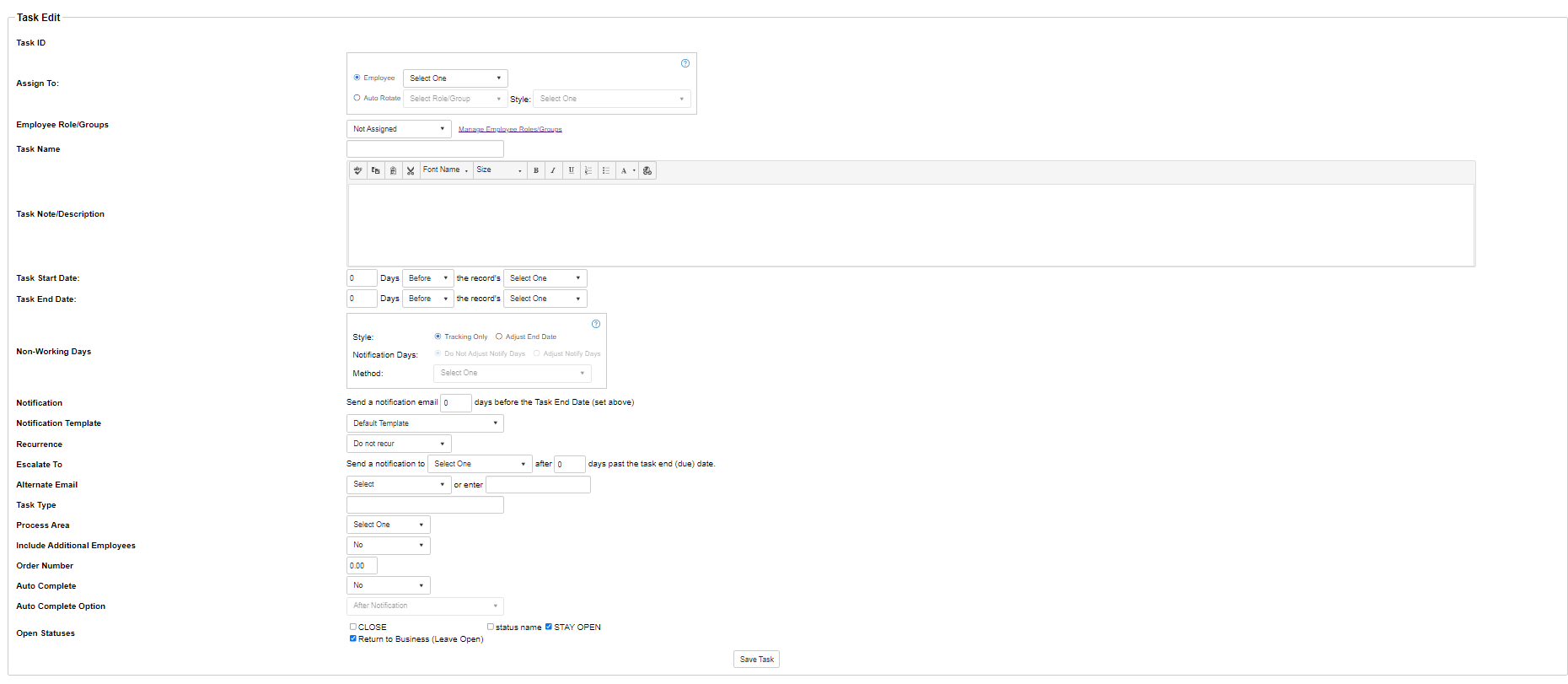
After clicking Save Task, the Task will be available in the Tasks List section toward the top of the screen. Clicking Delete on the side deletes the Task while clicking Edit allows admin users to edit it. Editing a Task will reveal the Field Updates. Typically, one task/notification should be created in each workflow step.
NOTE: Typically, Time Elapsed and Field Conditions will trigger Workflow tasks.

Field Update on Compete/Reject
Field Updates on Complete/Reject
This page is a continuation of the Task Creation & Management page, but the information here can also be used independently/for existing Workflow.
When Editing an existing Workflow Task, an additional module labeled Field Updates Associated With (Task Title) displays. Designate Field Updates that occur when the Task is Completed or Rejected in this area. Click Add New Update to add an update.

Designate whether the Update is for when the Task is Completed or when the Task is Rejected. Then, select the Field that is being Updated. After selecting the Field, the pop-up will reload to allow you to designate the new Value. In the example below, we set the Task to Update the Status to Active if Completed, or to Update the Status to Declined if Rejected. Use the Delete or Edit buttons to Delete or Edit the Field Updates.
NOTE: Status is the most commonly updated field in Field Updates

Please note that field updates are not limited to one of each.

When handling multi-step Workflow, a good general practice is to use multiple Workflow Records, where the initial Workflow will Update a Field so that the new Value is a Criteria of the next Workflow, triggering it. This can be repeated until the Workflow is complete.
To watch more about Workflow Tasks and Field Updates, watch the video below.
.png)

